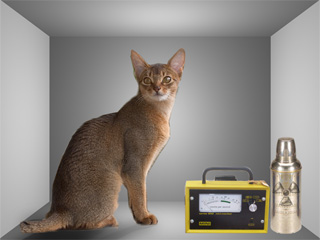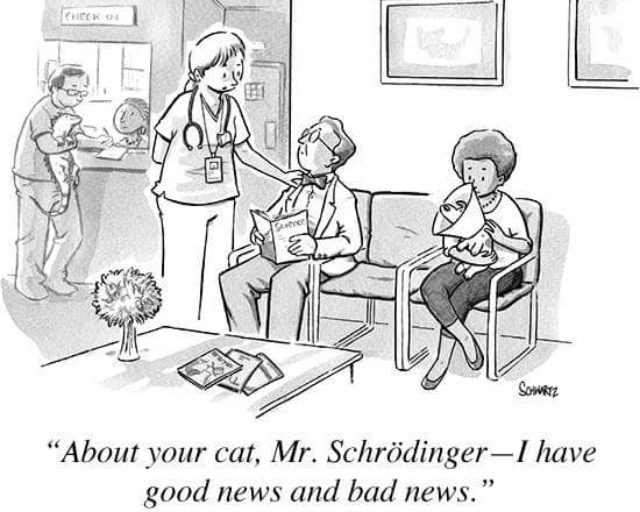|
Now to the newsletter:
Austrian physicist Erwin Schrödinger received the 1933 Nobel Prize in Physics for developing a mathematical basis for quantum mechanics. He and Einstein both made essential contributions to the development of quantum mechanics, but both were repelled by an inevitable consequence of their work: the Heisenberg uncertainty principle.
In 1935, Schrödinger concocted a bizarre thought experiment intended to show that quantum mechanics leads to irrational conclusions. Be assured, this thought experiment was never actually performed — no real cat suffered this famous, but politically incorrect, experiment.

Schrödinger’s cat, call him Felix, is sealed inside a box with a radioactive source, a detector, and a bottle of poison gas. When the detector first senses a radioactive decay, it releases the poison gas.
Radioactive sources obey quantum rules; they decay at precisely known rates, but each atom decays at a random, unpredictable moment. The probability of at least one decay increases steadily over time, but exactly when the first decay will occur is completely unpredictable.
Schrödinger posed this question: When the probability of detecting the first decay reaches 50%, is Felix alive, dead, or both? Both? Who would be crazy enough to say both? Quantum mechanics would.
Niels Bohr said Felix would be in a combined quantum state of equal parts alive and dead. Felix remains in this combined state until we open the box and observe him. At that instant, Felix’s combined state “collapses” and he then becomes either 100% alive or 100% dead. Bohr said: “Nothing exists until it is measured.” (In this context, observation is a form of measurement.) Bohr’s view is akin to “don’t ask; don’t tell.” If we don’t ask the state of nature (by making a measurement), we cannot tell what state it is in. Speculating about the cat’s state in the absence of measurement is meaningless, Bohr believed. Reality is only what is observed.
Einstein and Schrödinger thought all this was crazy. At any moment, Felix must be either alive or dead, but certainly never both. Also, they firmly believed that Felix’s fate cannot depend on whether or not we observe him. Reality exists independent of human observation, they believed. As Einstein said: “Would the Moon disappear if we stop looking at it”.
If Felix were a subatomic particle, Bohr’s view would be correct. In the micro-world, subatomic particles really can exist simultaneously in combinations of very different, even incompatible, states. This condition, called quantum superposition, requires coherence. Superposition states can exist only as long as the combining states remain coherent. Typically, coherence ends when a substantial interaction occurs with something external. Macro-world objects like Felix cannot persist in a quantum superposition of radically different states — they lose coherence in less than a microsecond. While no one completely understands the transition from life to death, most would agree the process takes longer than a millionth of a second.
A practical example may help. Quantum superposition is the core technology in the ongoing development of quantum computers. In normal computers, numbers are stored in bits, each equal to either 1 or 0. An 8-bit device can store any one value from 0 to 255. In quantum computers, an 8-qubit device can store a quantum superposition of every value from 0 to 255. A 32-qubit device could store four billion values at the same time. Calculations could be done with all these values simultaneously, expanding computing power exponentially. While quantum computers are not yet practical, they have the potential to do what no current computer can: crack the secret codes of every bank and every nation. Enormous effort and money is being invested trying to make quantum superposition a practical reality. So far, the world’s most advanced technology can barely maintain coherence for a handful of atoms for a tiny fraction of a second.
Felix is a Fat Cat, with a million, million, million atoms. The myriad interactions between the particles in Felix, the air, the enclosure walls, the radioactive source, the detector, and the poison gas inevitably alter the frequencies and phases of quantum wave functions. Any coherence between “alive-Felix” and “dead-Felix” states is disrupted within a microsecond by innumerable chaotic interactions. Quantum coherence is far too delicate to withstand the scale and brutality of the macro-world.

While all his physicist friends are long gone, Schrödinger’s cat lives on in quantum lore. Felix enjoys the last meow.

Best Regards,
Robert
November, 2019
Note: Previous newsletters can be found on my website.
|